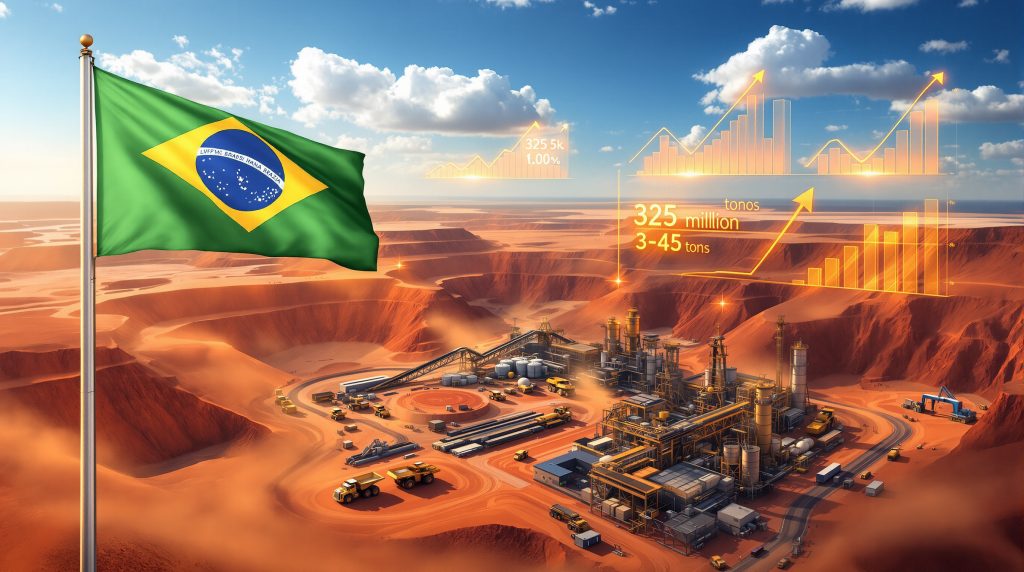Vale's Iron Ore Production Targets for 2025
Vale's 2025 iron ore production forecast positions the Brazilian mining giant to deliver between 325-335 million tons, with company management expressing strong confidence in achieving the upper end of this ambitious range. This production target represents a critical milestone in Vale's operational recovery following the devastating Brumadinho dam disaster in January 2019, which claimed 270 lives and suspended approximately 40 million tons of annual production capacity.
The company's journey back to peak performance has been methodical and strategic, with safety improvements and regulatory compliance taking precedence over pure volume maximization. Vale's current production trajectory demonstrates not only operational excellence but also the successful integration of mining innovation trends and sustainable practices across its Brazilian operations.
Breaking Down Vale's Production Performance Metrics
Vale's third quarter 2025 results showcase remarkable operational momentum, with iron ore production reaching 94.4 million tons, marking a 3.8% increase year-over-year and representing the highest quarterly output since late 2018. This performance milestone signals the company's successful navigation through years of capacity constraints and regulatory challenges.
The nine-month production total of 245.7 million tons positions Vale at approximately 73-76% of its full-year guidance range, providing substantial confidence for upper-range targeting. This production acceleration through the year demonstrates effective operational management and strategic resource allocation across multiple mining complexes.
| Metric | Q3 2025 | Q3 2024 | Change |
|---|---|---|---|
| Iron Ore Production | 94.4 million tons | 91.0 million tons | +3.8% |
| Iron Ore Sales | 86.0 million tons | 81.8 million tons | +5.1% |
| Average Realised Price | $94.4/ton | $90.6/ton | +4.2% |
| Quarterly Revenue Impact | ~$8.1 billion | ~$7.4 billion | +9.5% |
The differential between production and sales volumes in Q3 2025 indicates strategic inventory building of approximately 8.4 million tons, suggesting tactical positioning for seasonal demand patterns or price optimisation opportunities. This inventory management reflects sophisticated market timing capabilities that enhance overall revenue realisation.
S11D Mining Complex: The Production Powerhouse
Vale's S11D project in Brazil's Carajás region has emerged as the cornerstone of production growth, achieving record third-quarter output in its operational history. This world-class mining operation, which required $14.3 billion in investment, represents one of the largest mining developments in Brazilian history and showcases advanced extraction technologies that set industry benchmarks.
The S11D complex operates with nominal capacity of 90 million tons annually and produces premium-grade iron ore averaging 66.7% iron content, significantly exceeding the industry benchmark of 62% iron content. This superior ore quality commands premium pricing of $5-15 per ton above standard grades, depending on prevailing market conditions.
S11D Technical Innovation Features:
• Truck-less mining system utilising over 100 kilometres of conveyor belts
• Natural moisture processing that eliminates traditional tailings dams
• Automated ore handling systems reducing water consumption by 93%
• Digital integration enabling real-time production optimisation
• Environmental performance generating 30% less CO2 per ton versus legacy operations
The operation's strategic importance extends beyond raw production volumes. S11D's low impurity profile, with silica content of 1.5-2.0% and alumina content of 1.0-1.5%, makes it particularly valuable for modern steelmaking processes focused on emissions reduction. As global steel producers transition toward cleaner production technologies, high-grade ore like S11D's output becomes increasingly strategic.
Operational Excellence Driving Upper-Range Confidence
Vale's management confidence in achieving upper-range production targets stems from multiple operational improvements and project ramp-ups across their mining portfolio. The Vargem Grande Complex resumed operations in December 2023, adding approximately 13 million tons of annual capacity following extensive regulatory approvals and safety upgrades.
The Capanema mine restarted production in June 2024, contributing approximately 6 million tons annually, while the Serra Leste expansion project continues ramping toward full capacity of 6 million tons per year. These capacity additions, combined with operational efficiency improvements, provide the foundation for sustained production growth.
Infrastructure Capacity Analysis:
• Ponta da Madeira port: 230 million tons annual capacity
• Southern System ports (Tubarão and Guaíba): 100 million tons combined capacity
• Carajás Railway (EFC): 230 million tons transportation capacity
• Total logistics capacity: Over 330 million tons, exceeding production targets
Vale's implementation of autonomous haulage systems, with approximately 70 autonomous trucks operating across Brazilian mines, demonstrates commitment to technological advancement. These systems enhance operational consistency while reducing labour costs and safety risks associated with traditional mining operations.
Market Dynamics and Strategic Positioning
Global iron ore market conditions present both opportunities and challenges for Vale's production strategy. The seaborne iron ore trade totalled approximately 1.65 billion tons in 2024, with China accounting for roughly 70% of imports at 1.15 billion tons annually. This market concentration creates both opportunity and risk for major producers like Vale.
Chinese steel production reached approximately 1.02 billion tons in 2024, representing 54% of global output. However, challenges in China's property sector have reduced steel consumption, with real estate construction steel demand declining 15-20% year-over-year. Furthermore, understanding iron ore price trends and iron ore demand insights helps inform strategic decisions regarding inventory management and sales timing.
Market Reality Check: While production capacity supports upper-range targets, global steel demand fluctuations and Chinese market dynamics continue influencing strategic decisions regarding inventory management and sales timing.
Iron ore pricing dynamics remain volatile, with benchmark 62% Fe CFR China prices ranging from $95-130 per ton during 2024. Vale's realised price of $94.4 per ton in Q3 2025 reflects both market conditions and the company's strategic approach to maximising revenue through quality premiums and contract optimisation.
The global steel industry's transition toward decarbonisation technologies, including electric arc furnaces and direct reduced iron processes, increasingly favours high-grade iron ore with low impurities. This trend positions Vale's premium Carajás production advantageously for long-term market development.
Diversified Production Beyond Iron Ore
Vale's copper production demonstrates strong performance trajectory, reaching 90,800 tons in Q3 2025, representing a 5.7% year-over-year increase. The company's copper guidance for 2025 targets 340,000-370,000 tons, with production trending toward the upper range of expectations, particularly given recent copper price predictions suggesting continued market strength.
Copper Operations Portfolio:
• Salobo mine (Brazil): ~200,000 tons annual capacity
• Sossego mine (Brazil): ~40,000-45,000 tons annually
• Canadian operations (Sudbury): ~70,000-80,000 tons annually
Nickel production faced minor challenges in Q3 2025, declining 0.6% to 46,800 tons due to planned maintenance at the Copper Cliff refinery in Ontario. However, the Long Harbour refinery in Newfoundland achieved record production levels, demonstrating operational excellence across Vale's nickel portfolio.
Vale's position as the world's second-largest nickel producer, with guidance of 165,000-180,000 tons for 2025, benefits from growing electric vehicle battery demand. The company's refined nickel products qualify as Class 1 material suitable for battery applications, positioning Vale favourably as EV adoption accelerates globally.
Capital Investment Strategy Supporting Growth
Vale's capital expenditure guidance of $5.4-5.7 billion for 2025 reflects strategic investment in sustaining production growth while maintaining operational flexibility. This investment allocation prioritises equipment upgrades, digital transformation initiatives, environmental compliance, and logistics infrastructure enhancement.
Investment Priority Areas:
• Mining equipment modernisation and autonomous system deployment
• Digital integration and process automation technologies
• Environmental monitoring and sustainability infrastructure
• Port and railway capacity optimisation projects
The company's focus on technology integration includes mine-to-port digital systems enabling real-time optimisation of production and logistics coordination. These investments support not only current production targets but also long-term operational efficiency and cost competitiveness.
Environmental investment remains a critical component, with projects focused on water recycling systems, emissions reduction, and biodiversity conservation. Consequently, the mining decarbonisation benefits become increasingly apparent. S11D's water recycling rate exceeding 95% exemplifies the company's commitment to sustainable mining practices that meet evolving regulatory requirements.
What Are The Key Risk Factors and Mitigation Strategies?
Despite strong performance indicators, several variables could influence final production outcomes. Seasonal rainfall patterns in Brazil's mining regions historically impact extraction and transportation activities, particularly during the December-March rainy season. Vale's infrastructure investments in covered conveyor systems and port storage facilities help mitigate weather-related disruptions.
Key Risk Categories:
• Weather disruptions affecting mining and logistics operations
• Large-scale equipment maintenance requirements and availability
• Regulatory changes in environmental or safety standards
• Market volatility influencing production scheduling decisions
• Geopolitical factors affecting global trade flows
Vale's risk management approach includes maintaining strategic inventory buffers, diversifying transportation routes, and implementing predictive maintenance programmes that minimise unplanned equipment downtime. The company's operational flexibility allows for production scheduling adjustments based on market conditions and logistics constraints.
Regulatory compliance remains paramount following the Brumadinho disaster, with ongoing monitoring of dam safety protocols and environmental impact assessments. According to recent industry analysis, Vale's investment in alternative processing technologies that eliminate traditional tailings dams demonstrates proactive risk mitigation.
Competitive Landscape and Market Position
Vale's 2025 iron ore production forecast positions the company among the world's leading suppliers, competing directly with Australian giants Rio Tinto and BHP Billiton, along with other Brazilian producers. Vale's market share of approximately 13-15% of global seaborne iron ore trade provides significant influence over market dynamics.
Competitive Advantages:
• Production scale enabling cost efficiency through economies of scale
• Geographic proximity to key South American and North American markets
• Premium ore quality commanding higher pricing versus benchmark grades
• Integrated logistics network reducing per-ton transportation costs
• Proven reserves of 12.8 billion tons supporting long-term production sustainability
Vale's competitive positioning benefits from operational improvements implemented since 2019, including enhanced safety protocols, technological upgrades, and streamlined logistics systems. These improvements support cost competitiveness while maintaining production reliability.
The company's customer diversification strategy, with approximately 65-70% of sales to Asian markets, 10-15% to European customers, and 15-20% to Americas markets, provides geographic risk mitigation while capturing regional premium pricing opportunities.
How Does Vale's Performance Compare To Industry Expectations?
Recent reports show that Vale has achieved record iron ore production in Q3 2025, with the company expecting to reach its highest production level in 2025 after posting the strongest quarter since 2018. However, it's worth noting that the company has slightly adjusted some aspects of its outlook for the full year.
Long-Term Strategic Implications
Achieving upper-range production targets would establish Vale's operational credibility and strengthen market position heading into 2026 and beyond. Successful execution of 2025 goals demonstrates the company's ability to deliver on ambitious commitments while maintaining operational flexibility in dynamic market conditions.
Future Growth Considerations:
• Expansion project pipeline development for post-2025 capacity growth
• Sustainability initiative integration supporting ESG investment criteria
• Technology advancement implementation enhancing operational efficiency
• Market share consolidation opportunities through strategic partnerships
• Supply chain integration improving margins and customer relationships
Vale's long-term strategy emphasises sustainable growth that balances production maximisation with environmental stewardship and community engagement. The company's commitment to achieving net-zero emissions by 2050 requires continued investment in clean technologies and operational optimisation.
The global transition toward renewable energy and electric vehicles creates both opportunities and challenges for Vale's diversified mining portfolio. Increased demand for copper and nickel in clean energy applications supports production expansion while iron ore demand evolution requires strategic planning for changing steel industry requirements.
Vale's 2025 iron ore production forecast of 325-335 million tons represents more than numerical targets; it demonstrates operational resilience, strategic planning, and commitment to sustainable mining practices. With robust quarterly performance supporting upper-range confidence, the company appears well-positioned to deliver on ambitious production commitments whilst adapting to evolving market conditions.
The combination of record-breaking quarterly results, successful project ramp-ups, and diversified portfolio performance creates a foundation for sustained growth extending beyond 2025. Vale's strategic investments in technology, sustainability, and operational excellence position the company to maintain competitive leadership in global mining markets whilst meeting the evolving needs of steel producers worldwide.
Disclaimer: This analysis is based on publicly available information and company reports. Mining operations face inherent risks including weather, equipment failures, regulatory changes, and market volatility that could impact actual production results. Investors should conduct independent research and consider multiple factors when making investment decisions.
Ready to capitalise on major mining opportunities before the broader market catches on?
Discovery Alert instantly alerts investors to significant ASX mineral discoveries using its proprietary Discovery IQ model, turning complex mineral data into actionable insights for both short-term trading and long-term investment opportunities. Understand why major mineral discoveries can lead to substantial market returns by exploring Discovery Alert's dedicated discoveries page, showcasing historic examples of exceptional outcomes, and begin your 30-day free trial today to position yourself ahead of the market.




